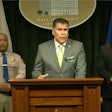The twin towers of the World Trade Center withstood the impact of the hijacked planes that crashed into them, but could not withstand the intense fires from ignited fuel, according to a federal report.
The fires disabled the water supply for hoses, sprinkler systems and other fire-suppression equipment in the buildings.
The structure of the buildings responded surprisingly well to the impact of the planes on Sept. 11, the report says, but the towers could not withstand the ensuing fires that burned as hot as 2,000 degrees and generated heat equivalent to the output of a nuclear power plant.
The findings of the report, commissioned by the Federal Emergency Management Agency and the American Society of Civil Engineers, were reported by The New York Times in Friday editions. The newspaper had obtained a draft copy of the report.
The report, which the newspaper said will be officially released in late April or early May, offers a detailed description of the sequence of events that brought the twin towers down.
The planes damaged support columns when they rammed into the towers, but the buildings successfully redistributed loads to other supports, the report said. It added that without the devastating fires, the towers probably would have remained standing indefinitely unless they were hit by an earthquake or a windstorm.













